Friends of Friendless Churches
The Friends of Friendless Churches is a registered charity formed in 1957 and active in England and Wales.[1] It campaigns for and rescues redundant historic churches threatened by demolition, decay, or inappropriate conversion.[2] To that end, as of September 2018, it owns 51 former churches or chapels, 26 of which are in England,[3][4] and 25 in Wales.[5]
History
The charity was formed in 1957 by Ivor Bulmer-Thomas, a writer, former MP and a high church Anglican,[6] who became its first chairman; its executive committee included prominent politicians and architects. Initially the charity campaigned and obtained grants for the repair and restoration of churches within its remit. The 1968 Pastoral Measure established the Redundant Churches Fund (now called the Churches Conservation Trust), which it was thought would obviate the need for the Friends. However, the Church Commissioners turned down a number of buildings that the executive committee considered worthy of preservation, including Old St Matthew's Church, Lightcliffe, and St Peter's Church, Wickham Bishops. The charity therefore decided in 1972 to change its constitution, allowing it to acquire threatened buildings either by freehold or by lease. The tower of the church at Lightcliffe was the first property to be vested with the charity.[7]
Activities
The charity raises money from a number of sources. Since 1999, it has been recognised in Wales as the equivalent of the Churches Conservation Trust (which only covers churches in England), and as a consequence receives full funding for taking Anglican churches into its care. Of this, 70% comes from the State via Cadw, and 30% from the Church in Wales.[8] In England, grants are sometimes obtained from bodies such as English Heritage, as in the case of St Mary's Church, Mundon,[9] but otherwise funds are raised by donations and local money-raising campaigns. Some of the churches have been supported by the formation of local groups of Friends, such as Caldecote Church Friends,[10] and the Friends of St Andrew's, Wood Walton.[11] Members of the public can make donations, become a member of the charity, or leave a legacy in their wills.[12] In addition the charity administers two trusts,[13] one of which, the Cottam Will Trust, was established by Rev S. E. Cottam for "the advancement of religion of objects of beauty to be placed in ancient Gothic churches either in England or Wales".[14] The charity works closely with the Ancient Monuments Society.[2]
All the churches owned by the charity are listed buildings, and most are former Anglican churches, either from the Church of England or the Church in Wales, although three were private chapels: one, the Strict and Particular Baptist Chapel, Waddesdon, was a Nonconformist chapel,[2] and another, St Mary of the Angels Church, Brownshill, was a Roman Catholic church.[4]
In 2007 the charity achieved its 50th anniversary, in celebration of which they published a book entitled Saving Churches, containing details of their history and accounts of their churches.[15]
In the financial year ending 31 March 2018, the income of the charity was £422,000 and its expenditure was £447,000.[1] Its patronage is vacant, following the death of the Marquess of Anglesey[16] in 2013. The ecclesiastical patron is Rev Wyn Evans, Bishop of St David's and the president is the Marquess of Salisbury.[17] Rachel Morley has been the director of the charity since 2018,[18] and as of May 2020 there were one and a half members of staff.[19]
List of vested churches
The list is in two sections, one for England and the other for Wales. This division reflects the former management of most of the English churches by the Church of England and of the Welsh churches by the Church in Wales, and the different funding arrangements in the two countries.
Key
| Grade | Criteria[20] |
|---|---|
| I | Buildings of exceptional interest, sometimes considered to be internationally important |
| II* | Particularly important buildings of more than special interest |
| II | Buildings of national importance and special interest |
England
| Name | Location | Image | Date[B] | Notes | Grade |
|---|---|---|---|---|---|
| St Peter | Wickham Bishops, Essex 51.7698°N 0.6434°E |
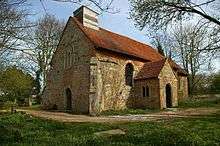 |
11th century | It is thought this was originally a private chapel for the Bishops of London, and then became a parish church. It was restored in 1850, but then became a chapel of ease in the parish of St Bartholomew. The fabric deteriorated and it was declared redundant in 1975. Since 1995 it has been used as an artist's studio.[21] | II*[22] |
| St Peter | Llancillo, Herefordshire 51.9250°N 2.9231°W |
 |
11th to 12th century | In a remote position near the England–Wales border, it is thought the site was used by a hermit in the 6th century. The church was restored in the 17th century, but it closed for public worship in 2006.[23][24] | II*[25] |
| Urishay Castle Chapel | Urishay, Peterchurch, Herefordshire 52.0328°N 2.9883°W |
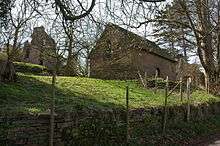 |
Early 12th century | The chapel is built in the bailey of the now-ruined Urishay Castle. A chancel was added in the 13th century, alterations were made in the 16th and 17th centuries, and restorations have been carried out during the 20th century. It has been under the care of the charity since 1978.[26][27] | II*[28] |
| St John | Allington, Wiltshire 51.1534°N 1.7095°W |
 |
12th century | Although it originated in the 12th century, only the chancel arch and part of a Norman arch remain from that period. The rest was built in 1847–51, and was designed by the "priest-architect" Fr William Grey.[29] | II[30] |
| St Mary | Temple, Corsley, Wiltshire 51.2021°N 2.2516°W |
.jpg) |
1902–3 | Private chapel built by the Barton Trust in Arts and Crafts Gothic, funded by Mary Barton in memory of her husband and son.[31] | II[32] |
| All Saints | Ballidon, Derbyshire 53.0867°N 1.6970°W |
.jpg) |
12th century | Originating in the 12th century, the church was much rebuilt and restored in the 19th century.[33] | II[34] |
| St Mary Magdalen | Boveney, Buckinghamshire 51.4903°N 0.6474°W |
12th century | The church stands on the north bank of the River Thames, and was built for bargemen working on the river. It was declared redundant in 1975 and came under the care of the charity in 1983. It was later found that the tower was unstable, and repairs costing £200,000 have been carried out, partially funded by choral concerts held at nearby Eton College.[35][36] | I[37] | |
| St Leonard | Spernall, Warwickshire 52.2572°N 1.8748°W |
 |
12th century | Alterations were made to the church in the 14th and 18th centuries. In the mid-19th century a chancel, porch and bellcote were added. It was declared redundant in 1972. After an application for conversion to a house was declined, it was bought by the Ancient Monuments Society to save it from demolition. A series of repairs has been carried out, and since 1983 it has been used as an artist's workshop.[38][39] | II*[40] |
| St John the Baptist | Sutterby, Lincolnshire 53.2306°N 0.0746°E |
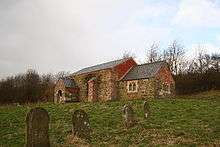 |
12th century | Additions were made to the church in the 14th century and a porch was built in 1743. It was made redundant in 1972. It was donated as a monument in 1981. Major repairs were carried out in 2002, and more are being undertaken in 2010.[41] | II[42] |
| St Mary | Hardmead, Buckinghamshire 52.1196°N 0.6358°W |
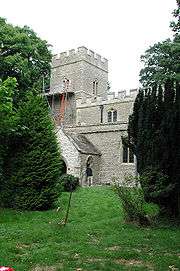 |
13th century | The church was built to serve a medieval village that has since disappeared. Additions were made to it in the 15th century. After it was declared redundant, it was proposed to convert it into a house, but it was acquired by the charity and, as of 2010, is managed by the Friends of Hardmead.[43] | I[44] |
| Ruins of St Andrew's Church | South Huish, South Hams, Devon 50.2555°N 3.8318°W |
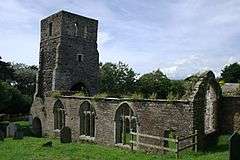 |
13th century | Additions were made to the church in the 14th and 15th centuries, but its fabric deteriorated and by 1866 it was considered to be beyond repair. A new church was built in a nearby village and all the fittings were removed. The charity has carried out work to slow down the rate of decay of the ruins, and services are held annually at the site.[45] | II*[46] |
| St Andrew | Woodwalton, Cambridgeshire 52.4241°N 0.2237°W |
 |
13th century | Additions and modifications have been made over the centuries since it was built. Because of its isolated position, it has suffered from theft and, since it was declared redundant, it has been subject to damage from vandalism. In addition the foundations are moving, leading to parts of the church settling at different rates. The church has been placed on the Heritage at Risk Register and applications have been made for grants towards its repair.[11][47][48] | II*[49] |
| St Mary | Fordham, Norfolk 52.5706°N 0.3838°E |
 |
13th century | The tower and south aisle were demolished in about 1730, leaving a simple church consisting of a nave and chancel, with a bellcote.[50] | II*[51] |
| St Denis | East Hatley, Cambridgeshire 52.1380°N 0.1235°W |
c.1300 | A simple church without tower or spire. The nave dates from about 1300; the chancel was rebuilt by William Butterfield in 1871–74, with a reredos articulated in different-coloured stones.[52] | II*[53] | |
| St Mary | Mundon, Essex 51.6912°N 0.7182°E |
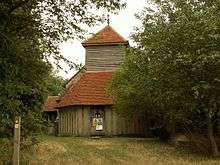 |
14th century | The church is constructed from a variety of materials; the nave is in stone, the chancel in brick, the aisle on three sides of the tower is timber-framed, the belfry is weatherboarded, and the roof is tiled. Some of the original 18th-century furniture is still present. Repair and conservation work, assisted by a grant of £140,000 from English Heritage, has been carried out.[9][54] | I[55] |
| St Mary Magdalene | Caldecote, Hertfordshire 52.0305°N 0.1989°W |
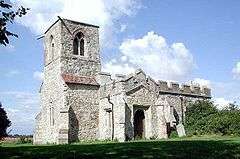 |
14th to 15th century | The church stands in a deserted medieval village that was abandoned mainly during the 15th and 16th centuries. It was repaired during the 18th century, but because of depopulation it was declared redundant in 1975. It has been under the care of the charity since 1982, and its survival is now assisted by the Caldecote Church Friends.[56][57][58] | II*[59] |
| Ayshford Chapel | Ayshford, Devon 50.9285°N 3.3555°W |
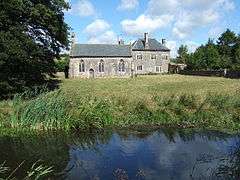 |
15th century | This was the private chapel of the Ayshford family of the adjacent Ayshford Court, and it was renovated in the 19th century. The charity undertook major work in 2001–02 that included restoration of the internal salmon-pink limewash, and repair of the stained glass.[60][61][62] | I[63] |
| St Mary | Eastwell, Kent 51.1900°N 0.8745°E |
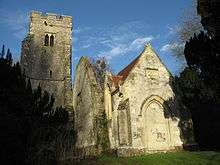 |
15th century | Only the tower, the wall of the south aisle, and the 19th-century mortuary chapel remain. The monuments formerly in the church have been moved, most of them to the Victoria and Albert Museum. The remains are a Scheduled Monument.[64][65] | II[66] |
| St Mary | Long Crichel, Dorset 50.8919°N 2.0334°W |
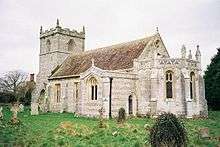 |
15th century | The Perpendicular tower dates from the 15th century. The rest of the church was rebuilt in 1851, although the interior is more Georgian than Gothic Revival in style.[4][67] | II[68] |
| Tower of St Peter's Church | Saltfleetby, Lincolnshire 53.3868°N 0.1573°E |
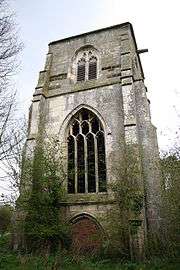 |
Late 15th century | The tower is the only surviving part of the structure of this former church. It was taken into the care of the charity in 1976.[69] | I[70] |
| St John the Baptist | Papworth St Agnes, Cambridgeshire 52.2639°N 0.1414°W |
 |
1530 | The church was almost completely rebuilt in the 19th century, to a design thought to be by its rector, Rev J. H. Sperling. By the 1970s it was largely derelict, and it was taken into the care of the charity in 1979. The church has been restored with the addition of a kitchen and toilets, and it is used as a community centre.[71][72] | II*[73] |
| Tuxlith Chapel | Milland, West Sussex 51.0478°N 0.8238°W |
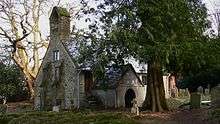 |
16th century | A gallery was added to the chapel in the 17th century, and during the following century the north transept was built. Because of population growth, a new larger church was built nearby in 1879, and the chapel was used as a Sunday school. This use continued until the 1930s, but the building's fabric subsequently deteriorated and it was declared redundant in 1974. The chapel has been restored and is now used as a community centre, hosting concerts and other events.[74][75][76] | II[77] |
| Thornton-le-Beans Chapel |
Thornton-le-Beans, North Yorkshire 54.3075°N 1.3936°W |
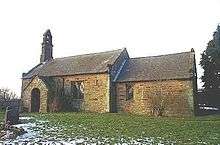 |
1770 | This has always been a chapel of ease in the parish of St Andrew, South Otterington. It is a stone chapel with a simple plan consisting of a nave and chancel, with a west bellcote.[4][78][79] | II[80] |
| Tower of Old St Matthew's Church | Lightcliffe, West Yorkshire 53.7245°N 1.7896°W |
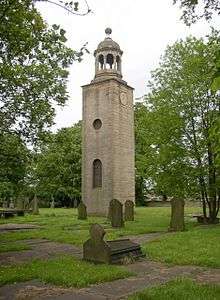 |
1775 | The Neoclassical style church was replaced in the late 19th century by a new church a short distance away, and it was then used as a mortuary chapel. It was damaged in a storm in the 1960s, and then suffered from vandalism. The body of the church was demolished, and the tower was taken into the care of the charity, who organised its repair.[81] | II[82] |
| Strict and Particular Baptist Chapel | Waddesdon, Buckinghamshire 51.8289°N 0.9085°W |
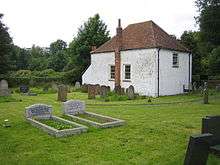 |
1792 | A porch and an extension were added in the 19th century. The chapel closed in 1976, and since then the charity has carried out repairs to the chapel and to its associated stables.[83][84] | II[85] |
| Chapel of St John the Baptist | Matlock Bath, Derbyshire 53.1311°N 1.5616°W |
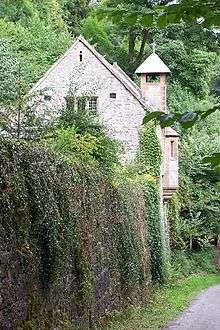 |
1897 | This was a private chapel for Mrs Louisa Sophia Harris, who commissioned Arts and Crafts artists to design the building and its fittings and furnishings. These included Guy Dawber, Louis Davis, George Bankart and John Cooke. Since taking it over, the charity has organised repairs and cleaning.[86][87] | II*[88] |
| St Mary of the Angels | Brownshill, Chalford, Gloucestershire 53.1311°N 1.5616°W |
— |
1930–37 | The church was built to serve the religious community of Templewood, later a Tertiary Chapter of the Dominican Order. It is the first Roman Catholic church to be vested in the charity.[4] | II[89] |
Wales
| Name | Location | Photograph | Date[B] | Notes | Grade |
|---|---|---|---|---|---|
| St Peulan | Llanbeulan, Anglesey 53.2513°N 4.4409°W |
 |
12th century | Despite a 19th-century restoration, the church has retained its simple medieval character. It contains a font that possibly dates from the pre-Norman era.[90] | II*[91] |
| St Jerome | Llangwm Uchaf, Monmouthshire 51.7009°N 2.8220°W |
 |
12th century | The church has 12th century origins and was restored in 1863–1878. Its features include a formidable tower to the north side, an elaborately carved early 15th century screen, 19th century floor tiles and the 19th century east window.[92] | I[93] |
| St Cynhaearn | Ystumllyn, Gwynedd 52.9262°N 4.1945°W |
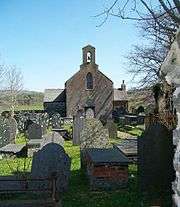 |
12th century | The church stands in an isolated position on what used to be an island in a former lake, and is approached by an ancient causeway. Its structure dates from the 12th, 16th and 17th centuries, while most of the interior fittings are Georgian in style, dating from 1832.[94] | II*[95] |
| St Mary, Tal-y-llyn | Near Aberffraw, Anglesey 53.2277°N 4.4484°W |
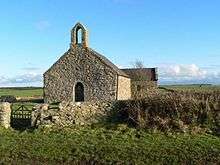 |
12th century (probable) | This is a simple medieval church that is virtually unrestored. Its fabric dates from the 12th century (probably) and the 16th and 17th centuries. Most of the furnishings are from the 18th century, although some have had to be replaced because of vandalism in the 20th century.[96] | I[97] |
| St Mary | Derwen, Denbighshire 53.0455°N 3.3882°W |
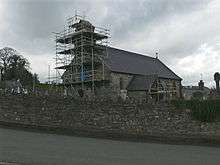 |
13th century | St Mary's Church retains late pre-Reformation stone carving, and a rood screen with its loft. Its fabric dates from the 13th century, and it was restored in 1857. The churchyard contains a pre-Reformation cross and a sundial, both of which are listed.[98][99] | I[100] |
| St Odoceus | Llandawke, Carmarthenshire 51.7732°N 4.4904°W |
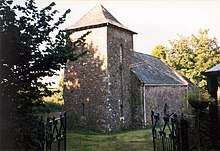 |
13th century | Having been built in the 13th century, it was remodelled during the following century, and restored in the Victorian era. When it was taken over by the charity in 2006 it was in "a state of dereliction"; repair and restoration work has been carried out.[101] | II[102] |
| St Ellyw | Llanelieu, Powys 52.0000°N 3.1887°W |
 |
13th century | In an isolated position in the Brecon Beacons, it has retained much of its medieval interior, including wall paintings and a rood screen. It is used as a venue for the annual Talgarth Festival.[103] | I[104] |
| St Michael and All Angels | Llanfihangel Rogiet, Monmouthshire 51.5850°N 2.7857°W |
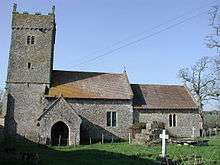 |
13th century | The church stands close to a group of farm buildings. Following a programme of restoration work by the charity, it is managed by the Local History Society.[105] | II*[106] |
| St Brothen | Llanfrothen, Gwynedd 52.9503°N 4.0521°W |
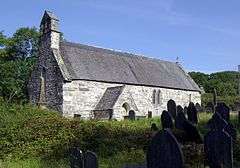 |
13th century | The church was re-roofed in the 15th century, additions were made in the 17th century, and restorations took place in the 19th century. It retains its rood screen constructed from the wood of trees felled between 1496 and 1506.[107] | I[108] |
| Hodgeston Parish Church | Hodgeston, Pembrokeshire 51.6585°N 4.8503°W |
 |
13th century (probable) | At the beginning of the 19th century the church was "in extreme disrepair". It was renovated in the 1850s, but retained many of its internal features, including a Norman font, a double piscina, and a triple sedilia.[109] | II*[110] |
| St Decumanus | Rhoscrowther, Pembrokeshire 51.6794°N 5.0332°W |
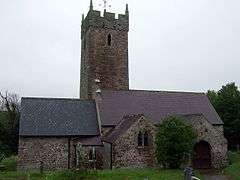 |
13th century (possibly) | Mainly medieval church with a tall tower, dedicated to St Decumanus (St Decuman). Has four side chapels associated with houses in the parish. Located beside a large oil refinery.[111] | I[112] |
| Manordeifi Old Church | Manordeifi, Pembrokeshire 52.0584°N 4.5855°W |
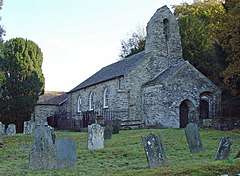 |
13th or 14th century | The church stands close to the River Teifi. Following repairs in the earlier part of the 19th century, it was abandoned as a parish church in 1899, and taken into the care of the charity in 2002. The tradition of keeping a coracle in the porch in case of flooding continues to be maintained.[113] | II*[114] |
| St Baglan | Llanfaglan, Gwynedd 53.1210°N 4.3095°W |
14th century | St Baglan's stands in an isolated position in a field. It escaped restoration in the 19th century, and retains its 18th-century furnishings, including communion rails, pulpit with sounding board, box pews and benches.[115] | I[116] | |
| St Beuno | Penmorfa, Gwynedd 52.9402°N 4.1721°W |
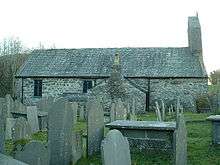 |
14th century | The chancel was added in the 15th century, and the vestry and porch in the 18th century. During the 19th century there were three restorations, but it retains its medieval roof.[117] | II*[118] |
| St Mary | Llanfair Kilgeddin, Monmouthshire 51.7731°N 2.9349°W |
 |
Mid to late 14th century (possible) | Although it was rebuilt in 1875–76, the church retains medieval contents, including a font. The walls are decorated in Arts and Crafts style sgraffito with designs by Heywood Sumner based on the Benedicite.[119] | I[120] |
| St Afran, St Ieuan and St Sannan | Llantrisant, Anglesey 53.3277°N 4.4798°W |
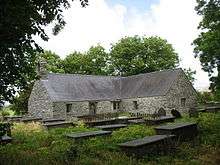 |
Late 14th century | Sited in an isolated position by a farm, it became redundant in 1899 when a new church was built nearer the centre of the settlement. By 1970 it was in ruins and without a roof. It was repaired in 1976–77 and came into the care of the charity in 2002.[121] | II*[122] |
| St Mary | Penllech, Gwynedd 52.8775°N 4.6466°W |
 |
15th century (probable) | The church stands on an old pilgrims' route. Although it was substantially rebuilt in 1840, its interior retains its Georgian style. Since coming under the care of the charity in 2009, repairs have been undertaken.[123] | II*[124] |
| St David | Llangeview, Monmouthshire 51.7017°N 2.8742°W |
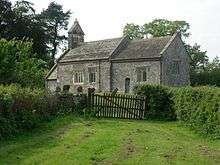 |
Late 15th century | The interior of the church is largely unrestored and contains a 15th-century rood screen with its loft, and rare pre-Victorian box pews and other fittings. It was declared redundant in 1999, and repairs to the exterior have been carried out.[125] | I[126] |
| St Figael | Llanfigael, Anglesey 53.3158°N 4.5114°W |
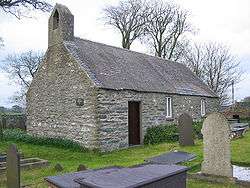 |
18th century (probable) | The church was largely rebuilt in 1841 and has retained most of its 19th-century interior. It also contains three fonts, the oldest dating back to the 12th century. Since taking it over, the charity has re-roofed it and reintroduced timber tracery in the windows.[127] | II[128] |
| St Andrew | Bayvil, Pembrokeshire 52.0314°N 4.7688°W |
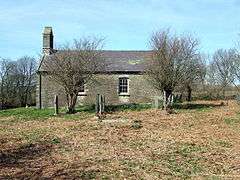 |
Early 19th century | This is thought to be an early 19th-century rebuild of a medieval church, and it has been unaltered since. Its features include box pews, a three-decker pulpit with a sounding board, and a 12th-century font.[129] | II*[130] |
| St Michael's Church | Tremain, Ceredigion 52.1078°N 4.5782°W |
 |
1846–48 | John Jones, otherwise known by his bardic name of Talhaiarn, designed the church in Early English style. Jones is acknowledged as the first Welsh architect to have been trained formally, and this is the only building he designed exclusively by himself.[131] | II*[132] |
| St Mark | Brithdir, Gwynedd 52.7487°N 3.8332°W |
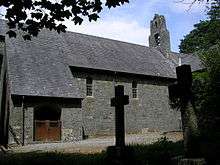 |
1895–98 | Designed by Henry Wilson, this is considered to be one of the finest Arts and Crafts churches in Wales. It was commissioned in memory of Rev Charles Tooth, founder of St Mark's English Church, Florence.[133] | I[134] |
| St Teilo | Llandeloy, Pembrokeshire 51.8975°N 5.1162°W |
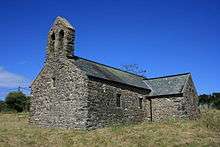 |
1926 | The church was built from medieval ruins and designed by John Coates Carter based on the principles of the Arts and Crafts Movement. Its interior is dominated by a carved rood screen and a painted reredos.[135] | II[136] |
See also
- Churches Conservation Trust – the trust for redundant Church of England churches in England
- Historic Chapels Trust – the trust for redundant non-Anglican places of worship in England
Notes
A The distinctive characteristic of voluntary sources is that the donor receives nothing in return for the money given. It includes grants from government and other charitable sources, as well as public gifts, donations and legacies.[137]
B This is the date of first construction of the existing building.
References
- Charity Commission, Friends of Friendless Churches, registered charity no. 1113097, retrieved 11 September 2019
- Notes for Editors, Friends of Friendless Churches, retrieved 12 November 2016
- "English Churches". Friends of Friendless Churches. Retrieved 22 September 2018.
- New Vestings, Friends of Friendless Churches, archived from the original on 13 August 2012, retrieved 21 May 2014
- "Welsh Churches". Friends of Friendless Churches. Retrieved 22 September 2018.
- Anglesey (2004) 'Thomas, Ivor Bulmer (1905–1993)', Oxford Dictionary of National Biography, Oxford University Press, Retrieved on 7 August 2010. (subscription or UK public library membership required)
- Early History of the Friends, Friends of Friendless Churches, retrieved 12 November 2016
- The Friends in Wales, Friends of Friendless Churches, archived from the original on 12 November 2016, retrieved 12 November 2016
- Mundon St Mary, Friends of Friendless Churches, retrieved 12 November 2016
- Caldecote Church Friends, Caldecote Church Friends, retrieved 25 July 2010
- St Andrew's Church, Wood Walton, The Friends of St Andrew's, Wood Walton, retrieved 25 July 2010
- Join Us, Friends of Friendless Churches, retrieved 12 November 2016
- Church Trust Funds, Friends of Friendless Churches, retrieved 12 November 2016
- Funding For Art In Churches, Friends of Friendless Churches, retrieved 12 November 2016
- Our book, Friends of Friendless Churches, retrieved 12 November 2016
- Officers and Executive Committee, Friends of Friendless Churches, archived from the original on 17 May 2013, retrieved 16 July 2013
- Officers and Executive Committee, Friends of Friendless Churches, archived from the original on 15 November 2016
- "Rachel Morley appointed as Friends of Friendless Churches' new Director". Heritage Update. 14 December 2017. Retrieved 20 May 2020.
- @friendschurches (20 May 2020). "Rachel on who we are, what we do and why we do it" (Tweet) – via Twitter.
- Listed Buildings, Historic England, retrieved 24 March 2015
- Wickham Bishops Old St Peter, Friends of Friendless Churches, retrieved 12 November 2016
- Historic England, "Church of St Peter, Wickham Bishops (1111019)", National Heritage List for England, retrieved 6 December 2011
- Llancillo, Friends of Friendless Churches, retrieved 12 November 2016
- Parish Church of St Peter, Llancillo: architecture, construction and history, Royal Commission on Historical Monuments: Herefordshire, 1, Ewyas Lacy Study Group, c. 1930, retrieved 14 July 2010
- Historic England, "Church of St Peter, Llancillo (1078169)", National Heritage List for England, retrieved 6 December 2011
- Urishay Castle Chapel, Friends of Friendless Churches, retrieved 12 November 2016
- Chapel at Urishay Castle, Herefordshire Council, archived from the original on 9 June 2011, retrieved 14 July 2010
- Historic England, "Urishay Chapel, Peterchurch (1099487)", National Heritage List for England, retrieved 6 December 2011
- Allington, St John the Baptist, Friends of Friendless Churches, retrieved 12 November 2016
- Historic England, "Church of St John the Baptist, Allington (1300482)", National Heritage List for England, retrieved 6 December 2011
- St Mary's, Corsley, Friends of Friendless Churches, retrieved 3 May 2020
- Historic England, "Church of St Mary, Corsley (1180496)", National Heritage List for England
- Francis, Rob (2003), All Saints Church, Ballidon: A long history but an uncertain future?, Parwich & District Local History Society, retrieved 5 December 2010
- Historic England, "All Saints Church, Ballidon (1109343)", National Heritage List for England, retrieved 5 December 2011
- Boveney St Mary Magdalene, Friends of Friendless Churches, retrieved 12 November 2016
- St Mary Magdalen, Boveney, Parish of Eton with Eton Wick and Boveney, retrieved 13 July 2010
- Historic England, "Chapel of St Mary Magdalene, Boveney (1309414)", National Heritage List for England, retrieved 6 December 2011
- Spernall St Leonards, Friends of Friendless Churches, retrieved 12 November 2016
- Styles, Philip, ed. (1945), "Parishes: Spernall", Victoria County History, A History of the County of Warwick, University of London & History of Parliament Trust, 3: Barlichway hundred, pp. 172–174, retrieved 15 July 2010
- Historic England, "Church of St Leonard, Spernall (1024518)", National Heritage List for England, retrieved 6 December 2011
- Sutterby St John the Baptist, Friends of Friendless Churches, retrieved 12 November 2016
- Historic England, "Church of St John the Baptist, Langton by Spilsby (1147550)", National Heritage List for England, retrieved 6 December 2011
- Hardmead St Mary, Friends of Friendless Churches, retrieved 12 November 2016
- Historic England, "Chapel of St Mary, Hardmead (1289532)", National Heritage List for England, retrieved 6 December 2011
- South Huish St Andrew, Friends of Friendless Churches, retrieved 12 November 2016
- Historic England, "Ruins of Church of St Andrew, South Huish (1108465)", National Heritage List for England, retrieved 6 December 2011
- Wood Walton St Andrew, Friends of Friendless Churches, retrieved 12 November 2016
- St Andrew's Church, Wood Walton, English Heritage, archived from the original on 26 August 2011, retrieved 14 July 2010
- Historic England, "Church of St Andrew, Wood Walton (1130123)", National Heritage List for England, retrieved 6 December 2011
- Newsletter, Friends of Friendless Churches, Autumn 2011, pp. 4–6
- Historic England, "Church of St Mary, Fordham (1205531)", National Heritage List for England, retrieved 6 December 2011
- Newsletter, Friends of Friendless Churches, Spring 2014, pp. 5–7
- Historic England, "Church of St Denis, East Hatley (1128153)", National Heritage List for England, retrieved 21 May 2014
- EXCITING NEWS! St Mary's Mundon is now safe and open daily!, Parish of St Mary the Virgin, Maldon with Mundon, archived from the original on 23 November 2010, retrieved 14 July 2010
- Historic England, "Redundant Church of St Mary, Mundon (1306956)", National Heritage List for England, retrieved 6 December 2011
- Caldecote St Mary Magdalene, Friends of Friendless Churches, retrieved 12 November 2016
- Pevsner, Nikolaus; Cherry, Bridget (rev) (1977) [1953], The Buildings of England: Hertfordshire, Harmondsworth: Penguin Books, p. 123, ISBN 0-14-071007-8
- Introduction, Caldecote Church Friends, retrieved 14 July 2010
- Historic England, "Church of St Mary Magdalene, Caldecote (1347341)", National Heritage List for England, retrieved 6 December 2011
- Ayshford Chapel, Friends of Friendless Churches, retrieved 12 November 2016
- Ayshford Chapel, Ayshford, Devon, Devon Ecobuild, retrieved 14 July 2010
- Cheshire, Jim (2004), Stained glass and the Victorian gothic revival, Manchester: Manchester University Press, p. 67, ISBN 978-0-7190-6346-6, retrieved 14 July 2010
- Historic England, "Ayshford Chapel, Burlescombe (1325900)", National Heritage List for England, retrieved 6 December 2011
- Eastwell St Mary, Friends of Friendless Churches, retrieved 12 November 2016
- Historic England, "'Eastwell Church (1005121)", National Heritage List for England, retrieved 6 December 2011
- Historic England, "Church of St Mary, Ruins, Eastwell (1071264)", National Heritage List for England, retrieved 6 December 2011
- Newsletter, Friends of Friendless Churches, Summer 2010, p. 6
- Historic England, "Church of St Mary, Long Crichel (1323488)", National Heritage List for England, retrieved 6 December 2011
- Saltfleetby Old St Peter, Friends of Friendless Churches, retrieved 12 November 2016
- Historic England, "West tower of former Church of St Peter, Saltfleetby (1165820)", National Heritage List for England, retrieved 6 December 2011
- Papworth St Agnes St John the Baptist, Friends of Friendless Churches, retrieved 12 November 2016
- Papworth St Agnes church, Papworth Team Churches, archived from the original on 25 June 2011, retrieved 14 July 2010
- Historic England, "Parish Church of St John the Baptist, Papworth St Agnes (1331388)", National Heritage List for England, retrieved 6 December 2011
- Milland, Friends of Friendless Churches, retrieved 12 November 2016
- Larner, Catherine (15 June 2007), "Brought back from neglect and decay", Church Times, Church Times (7527), retrieved 15 July 2010
- Salzman, L. F., ed. (1953), "Trotton", Victoria County History, A History of the County of Sussex, University of London & History of Parliament Trust, 4: The Rape of Chichester, pp. 32–39, retrieved 15 July 2010
- Historic England, "Milland Old Church (1216948)", National Heritage List for England, retrieved 6 December 2011
- Newsletter, Friends of Friendless Churches, Autumn 2008, pp. 4–5
- St Andrew South Otterington, Church of England, retrieved 10 September 2011
- Historic England, "Chapel of Ease, Thornton-le-Beans (1190670)", National Heritage List for England, retrieved 6 December 2011
- Lightcliffe Old St Matthew, Friends of Friendless Churches, retrieved 12 November 2016
- Historic England, "Tower to Old Church of St Matthew, Lightcliffe (1133792)", National Heritage List for England, retrieved 6 December 2011
- Waddesdon Hill Strict and Particular Baptist Chapel, Friends of Friendless Churches, retrieved 12 November 2016
- "Rarely used chapel opens to the public again", The Bucks Herald, Johnston Press Digital Publishing, 29 August 2007, retrieved 13 July 2010
- Historic England, "Baptist Chapel, Waddesdon (1117803)", National Heritage List for England, retrieved 6 December 2011
- Matlock Bath St John the Baptist, Friends of Friendless Churches, retrieved 12 November 2016
- Matlock's Churches and chapels, Ann Andrews, archived from the original on 14 July 2010, retrieved 14 July 2010
- Historic England, "Chapel of St John the Baptist, supporting retaining. wall and attached boundary walls, Matlock Bath (1248139)", National Heritage List for England, retrieved 6 December 2011
- Historic England, "St Mary of the Angels Roman Catholic Church, Chalford (1392073)", National Heritage List for England, retrieved 6 December 2011
- Llanbeulan St Peulan, Friends of Friendless Churches, retrieved 12 November 2016
- Church of St. Peulan, Cadw, retrieved 20 December 2016
- Llangwm Uchaf, Friends of Friendless Churches, retrieved 12 November 2016
- Church of St Jerome, Llangwm Uchaf, Cadw, retrieved 20 December 2016
- Ynyscynhaearn St Cynhaearn, Friends of Friendless Churches, retrieved 12 November 2016
- Church of St. Cynhaearn, Ystumllyn, Cadw, retrieved 20 December 2016
- Tal-y-Llyn St Mary, Friends of Friendless Churches, retrieved 12 November 2016
- Chapel of St. Mary (Tal-y-llyn) and churchyard walls, Cadw, retrieved 20 December 2016
- Derwen St Mary, Friends of Friendless Churches, retrieved 12 November 2016
- Hubbard, Edward (1986), The Buildings of Wales: Clwyd, London: Penguin, pp. 155–156, ISBN 0-14-071052-3
- St. Mary's Church, Derwen, Cadw, retrieved 20 December 2016
- Llandawke, Friends of Friendless Churches, retrieved 12 November 2016
- St. Odoceus' Church, Llandawke, Cadw, retrieved 20 December 2016
- Llanelieu St Ellyw, Friends of Friendless Churches, retrieved 12 November 2016
- Church of St Ellywe, Llanelieu, Cadw, retrieved 20 December 2016
- Llanfihangel Rogiet, Friends of Friendless Churches, retrieved 12 November 2016
- Church of St Michael and All Angels, Llanfihangel Rogiet, Cadw, retrieved 20 December 2016
- Llanfrothen St Brothen, Friends of Friendless Churches, retrieved 12 November 2016
- St. Brothen's Church, Llanfrothen, Cadw, retrieved 20 December 2016
- Hodgeston, Friends of Friendless Churches, retrieved 12 November 2016
- Hodgeston Parish Church, Cadw, retrieved 20 December 2016
- Rhoscrowther St Decumanus, Friends of Friendless Churches, retrieved 12 November 2016
- Church of St Decumanus, CADW, retrieved 20 December 2016
- Manordeifi Old Church, Friends of Friendless Churches, retrieved 12 November 2016
- Manordeifi Old Church, Cadw, retrieved 20 December 2016
- Llanfaglan St Baglan, Friends of Friendless Churches, retrieved 12 November 2016
- "St. Baglan's Church, Llanfaglan", Historic Wales, Cadw, retrieved 20 December 2016
- Penmorfa St Beuno, Friends of Friendless Churches, retrieved 12 November 2016
- Church of St Beuno, Penmorfa, Cadw, retrieved 20 December 2016
- Llanfair Kilgeddin St Mary, Friends of Friendless Churches, retrieved 12 November 2016
- Church of St Mary the Virgin, Llanfair Kilgeddin, Cadw, retrieved 20 December 2016
- Llantrisant SSS Afran, Ieuan & Sannan, Friends of Friendless Churches, retrieved 12 November 2016
- Church of St Afran, St Ieuan and St Sannan, Cadw, retrieved 20 December 2016
- Penllech St Mary, Friends of Friendless Churches, retrieved 12 November 2016
- Church of St Mary, Penllech, Cadw, retrieved 20 December 2016
- Llangeview St David's, Friends of Friendless Churches, retrieved 12 November 2016
- Church of St David, Llangeview, Cadw, retrieved 20 December 2016
- Llanfigael, Friends of Friendless Churches, retrieved 12 November 2016
- Church of St Figael, Cadw, retrieved 20 December 2016
- Bayvil St Andrew, Friends of Friendless Churches, retrieved 12 November 2016
- Church of St Andrew, Bayvil, Cadw, retrieved 20 December 2016
- "A New Vesting", Newsletter, Ancient Monuments Society and Friends of Friendless Churches, pp. 5–6, January 2012
- Church of St Michael, Tremain, Cadw, retrieved 20 December 2016
- Brithdir St Mark's, Friends of Friendless Churches, retrieved 12 November 2016
- Church of St Mark, Brithdir, Cadw, retrieved 20 December 2016
- Llandeloy St Eloi, Friends of Friendless Churches, retrieved 12 November 2016
- Church of St Teilo, Llandeloy, Cadw, retrieved 20 December 2016
- The Register of Charities — Notes for Users, Charity Commission, retrieved 2 August 2010
External links
- Official website

- Saunders, Matthew (2007), Fifty Years of the Friends of Friendless Churches, Historic Churches, Cathedral Communications, archived from the original on 13 November 2010, retrieved 7 August 2010
- Saunders, Matthew (March 2006), Protecting the disused but beautiful, 93, Institute of Historic Building Conservation, retrieved 7 August 2010
- Friendless Churches on Twitter